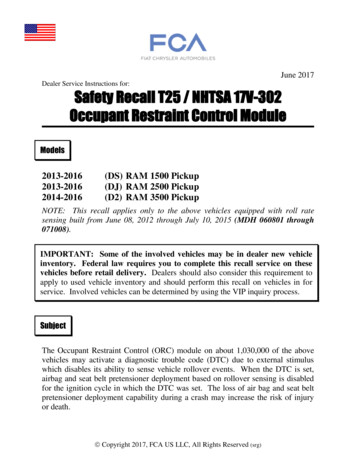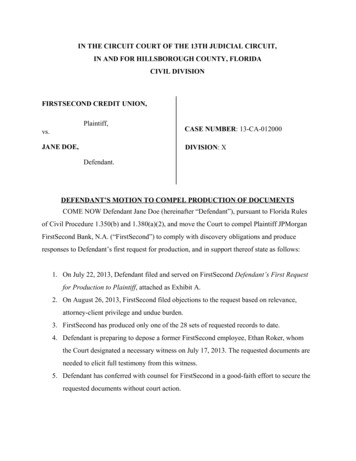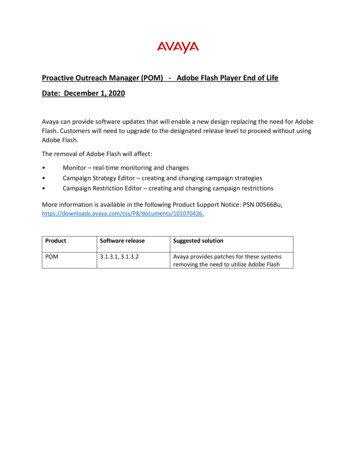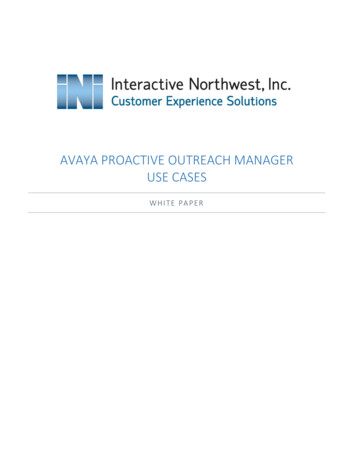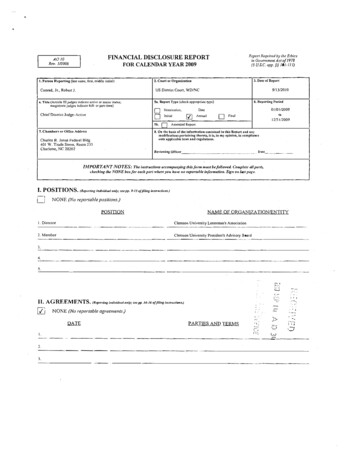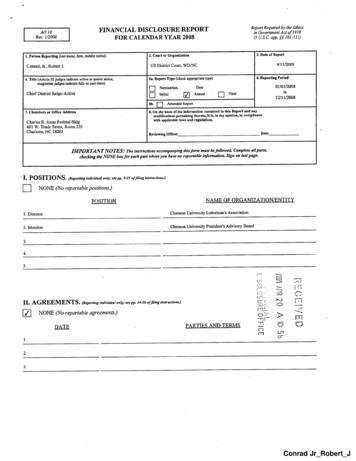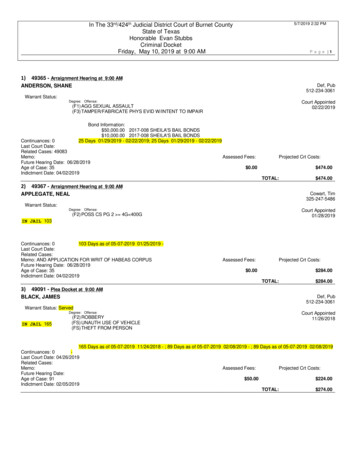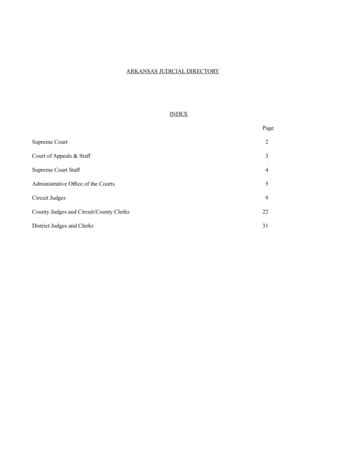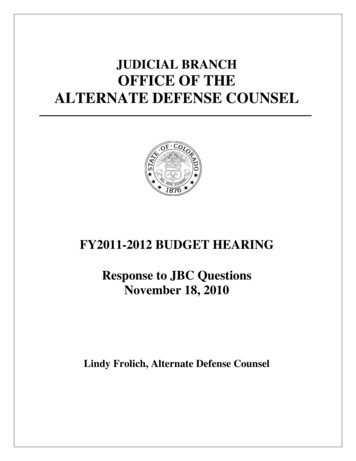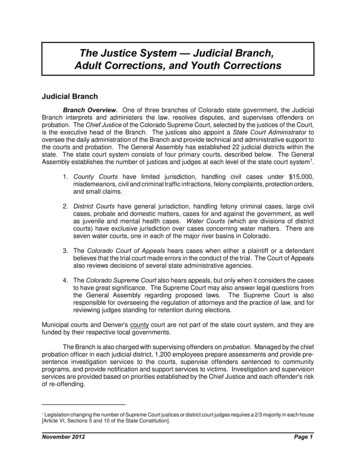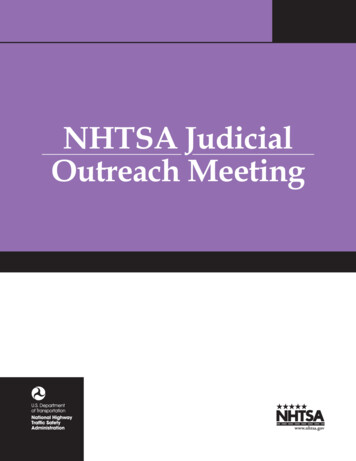
Transcription
NHTSA JudicialOutreach Meeting
NHTSA JUDICIAL OUTREACH MEETINGAugust 19, 2008EXECUTIVE SUMMARYOn August 19, 2008, the National Highway Traffic Safety Administration (NHTSA) hosted a JudicialOutreach meeting in Washington, DC, and included NHTSA’s Judicial Fellows, State and Regional JudicialOutreach Liaisons, and NHTSA headquarters and regional staff. The meeting provided an opportunity forparticipants to share ideas, success stories, and challenges with one another.The meeting focused on NHTSA’s priority programs for reducing impaired driving, in which members ofthe judiciary can play an important role, specifically: DWI courts Ignition interlocks Evidence-based or promising court, sentencing, and supervision practicesThis report summarizes presentations made regarding each of these priority programs. It alsosummarizes presentations made regarding other resources available to the judiciary, including theCentury Council’s judicial training efforts, a discussion of Data-Driven Approaches to Crime and TrafficSafety (DDACTS), data resources available from the National Center for Statistics and Analysis, and datatranslation capabilities available through the Federal Motor Carrier Safety Administration’s CommercialDriver’s License Information System (CDLIS).Meeting Attendees:Judicial Fellows: Hon. Yvette Diamond, Hon. Kent LawrenceNHTSA Regional Judicial Outreach Liaisons: Hon. Michael Padden (Region 10), Hon. Karl Grube (Region4), Hon. Lynda Howell (Region 9)State Judicial Outreach Liaison: Hon. David Hodges, TexasNHTSA: Nancy Ross, Ann Burton, Garrett Morford, Heidi Coleman, Mike Geraci, Jeff Michael, BrianChodrow, and Evelyn Avant, NHTSA HQ; Bill Kootsikas, NHTSA Region 9; Sandy Richardson, NHTSARegion 4Other Attendees: Bob Redmond, Federal Motor Carrier Safety Administration; Bill Georges, The CenturyCouncil; Robyn Robertson, Traffic Injury Research Foundation (TIRF); and Elizabeth Hurley, American BarAssociation (ABA)1
NHTSA JUDICIAL OUTREACH MEETINGAugust 19, 2008PRIORITY PROGRAM PRESENTATIONSI. PRESENTATION ONE: OVERVIEW OF IMPAIRED-DRIVING PRIORITIESTo set the stage for the meeting discussion, Heidi Coleman, Chief of NHTSA’s Impaired Driving Division,gave an overview detailing NHTSA priority programs in the impaired-driving area.Key points: A 3.7-percent decline in 2007 impaired-driving fatalities in crashes involving drivers ormotorcycle operators with a blood alcohol concentration (BAC) of .08 grams per deciliter (g/dL)or above (2007: 12,998 versus 2006: 13,470). 32 percent of 2007 fatalities involved a driver or motorcycle operator with a BAC of .08 g/dL orgreater. 86 percent of all alcohol-positive fatal crashes involved drivers or motorcycle operators at .08 orgreater. NHTSA is engaged in a number of priority programs to reduce impaired driving, including:1. High-Visibility Enforcement: efforts include general deterrence; the NationalCrackdown; sustained high-visibility enforcement; a national communications strategy;2. Support for the Criminal Justice System: efforts include Traffic Safety ResourceProsecutors; Judicial Fellows and Judicial Outreach Liaisons; DWI courts;3. Screening and Brief Intervention: efforts include working with the medical and healthcare community to screen and provide brief intervention with patients who show signsof an alcohol misuse problem; and4. Ignition Interlock: efforts are underway to increase use of interlocks, includingdevelopment of a judicial primer and ignition interlock curriculum; technical assistanceto States; elements of a model interlock program; case studies; rural demonstrationproject; blue ribbon panel. Priority areas in which judges can play the most critical role include:1. Promotion of DWI courts;2. Promotion of use of ignition interlocks; and3. Identification and promotion of evidence-based and promising court, sentencing, andsupervision practices for DWI offenders.DISCUSSIONFollowing the Impaired Driving Priorities presentation, meeting participants raised the following issues:The use of NHTSA’s new alcohol measure - a driver or operator involved in a crash with a .08 orgreater BAC alcohol-impaired versus the presence of any alcohol alcohol-related Represents a move towards intellectual honesty; using statistics that include crashes that couldarguably be caused by alcohol. NHTSA wants to be conservative yet emphatic about reporting alcohol involvement in impaireddriving crashes. Statistics previously used are still available for comparative purposes. Concerns that the new alcohol measure may underreport the involvement of low-BAC youngdrivers and low-BAC drivers with commercial driver licenses. Concern that the new measure’s elimination of low BACs does not track with society’s shifts inattitude away from the acceptability of drinking and driving.2
NHTSA JUDICIAL OUTREACH MEETINGAugust 19, 2008The need to focus on multiple young-driver issues Many issues are of concern for the safety of young drivers: underage drinking, texting whiledriving, other distractions, etc.NHTSA staff posed the following questions for consideration throughout the day’s discussions: How can judges help promote NHTSA priorities? What roles can Judicial Fellows and Judicial Outreach Liaisons play in this promotion? How can NHTSA best help judges?II. PRESENTATION TWO: DWI COURTSTo address the priority area of DWI courts, the Hon. Kent Lawrence, Judicial Fellow, shared hisperspectives. On the bench for 22 years, Judge Lawrence has run a DWI court in Athens, Georgia, since2001.Highlights from Judge Lawrence’s presentation included the following observations:Background of DWI courts Initial DWI courts are believed to have originated with Judge Michael Kavanaugh inAlbuquerque, New Mexico, more than 10 years ago. Primarily for repeat DWI offenders, U.S. DWI courts now number more than 400 and areconsidered “accountability courts,” or programs that combine chemical addiction treatmentwith behavior accountability expectations. Traditional sentences often don’t work for repeat DWI offenders. Courts continue to see thesame offenders over and over again. Money, technology, and advocacy groups alone won’tsolve these issues. Individual criminal justice system participants cannot solve the problem of repeat DWIoffenders. A team approach, including judges, prosecutors, defense attorneys, public defenders,law enforcement, probation, and treatment professionals, is necessary to collectively andsuccessfully redirect the behavior of offenders. Judge Lawrence said that “collective decisionsmade by a team are far superior to unilateral decisions made by a judge.”Success in DWI courts DWI courts must follow the 10 Guiding Principles for DWI courts as developed by the NationalDrug Court Institute (see http://www.ndci.org/pdf/Guiding Principles of DWI Court.pdf). The Four Goals of DWI Courts:1. Offender sobriety2. Increase in public safety3. Decrease in recidivism4. Return the offender to being a productive member of the community For most offenders, participating in a DWI court (or accountability program) is the “hardestthing these folks have ever done.” Offenders with the most convictions seem to have the most success in changing their behavior.They “want to please the judge” and their success may be age-related; older offenders tend tohave more convictions and appear more willing to make life changes.3
NHTSA JUDICIAL OUTREACH MEETINGAugust 19, 2008Why do DWI courts make a difference for repeat DWI offenders? In Judge Lawrence’s DWI court, his participants are:1. Held to a high standard of behavior;2. Subject to enhanced supervision of the court;3. Required to work unless they are disabled;4. Tested frequently for drugs and alcohol; and5. Subject to continued judicial monitoring. In Georgia, research shows DWI courts are working. Examining recidivism outcomes for threepilot DWI courts after four years, 1,100 DWI court accountability program participants had DWIrecidivism rates of 9 percent compared to 350 percent for similar offenders from the samecounties who were sentenced to traditional sanctions during a two-year period immediatelyprior to the establishment of DWI court programs. The DWI court program retention rate forparticipants was 79 percent.Obstacles and opportunities In Judge Lawrence’s opinion, the biggest obstacle to DWI courts are judges themselves. “Judgesdon’t like to surrender control,” Judge Lawrence said, “and some have no interest (in DWIcourts); some believe it isn’t their job to redirect behavior. That’s for corrections.” Judge Lawrence believes the future of DWI court programs lies with younger judges who have adifferent mindset and are more comfortable with technology. Operational since earlier this spring, the National Center for DWI Courts and its director, DavidWallace, are developing resources to assist judges, prosecutors, and law enforcement that arestarting DWI court programs. According to Judge Lawrence, the significant interest beingexpressed in DWI courts is the “tip of iceberg.”DISCUSSIONMeeting participants raised the following observations in a discussion following Judge Lawrence’spresentation.Giving up judicial independence to the judgment of the DWI court team Judges, while having ultimate control of the team, must be willing to use it sparingly andsurrender control to the group under some circumstances.Driver license issues for DWI court participants With the hard work being done by defendants in DWI court, should there be a consideration ofregaining driving privileges? How should issues of driving after suspension or revocation by DWI offenders be addressed?o At least one State had the legislature redefine the charge to a fine-only offense; anothercreated a two-track system: one track for driving-related suspensions, a second for“other” suspensions (e.g., not having a dog license).Support for DWI courts To foster community and legislative support for DWI courts, Judge Lawrence involved localemployers. Form a non-profit organization to accept community donations; use a powerful offender videofor victim impact panels. DWI courts can be self-sufficient with assistance from and partnerships within the community.4
NHTSA JUDICIAL OUTREACH MEETING August 19, 2008To get a DWI court going, redefine current court staff responsibilities; identify resources in thecommunity and “think outside the box”; extra effort from judges and others is required to get aDWI court started.Funding and incorporating treatment into DWI court programs is an ongoing challenge.Education of judges about DWI courts is critical, but all judges are not cut out to be DWI courtjudges.Legislators must believe DWI courts increase public safety; both legislators and the public mustbe educated about DWI courts if they are to be successful.III. PRESENTATION THREE: IGNITION INTERLOCKSPromoting the increased use and implementation of effective ignition interlock programs for impaireddrivers is a top priority for NHTSA. Robyn Robertson, president and CEO of the Traffic Injury ResearchFoundation (TIRF), shared information about a project TIRF is completing for NHTSA in her presentation,“Developing a National Curriculum on Ignition Interlocks.”Key observations from Robertson’s presentation included:Background on ignition interlock technology Despite advanced technology, supportive research, and laws that allow use, overall ignitioninterlock usage is low. A lack of familiarity in the criminal justice system with ignition interlocks is one reason for lowusage rates. TIRF’s Ignition Interlock Curriculum will provide needed educational opportunities for criminaljustice practitioners, including judges, to improve implementation and delivery.Ignition interlock implementation issues related to education needs Many new interlock laws are being considered and enacted. As of August 2008, 47 States authorized use of ignition interlocks for at least some offendersand 8 States required use of interlocks for all (including first) offenders. Many practitioners lack current knowledge of effectiveness and confidence in the devices and,therefore, use ignition interlocks for fewer offenders than are eligible (about 10% of all peoplearrested for DWI have interlocks installed). When practitioners are familiar with ignition interlock technology, they are more interested inusing it.TIRF’s Ignition Interlock Curriculum Funded by NHTSA, Alcohol Countermeasure Systems Corp., Smart Start, Inc., and Draeger. The curriculum is designed with input from law enforcement, attorneys, judges, probation,treatment professionals, and licensing agencies. Issues addressed in the curriculum include ignition interlock research, technology,implementation, legal issues and service providers. The curriculum is Web-based and includes a video demonstrating the use of an interlock deviceas well as a mock traffic stop involving an interlock. The report is now complete and can beobtained from the Century Council.5
NHTSA JUDICIAL OUTREACH MEETINGAugust 19, 2008Conclusions There is a need and an opportunity to provide criminal justice system practitioners, includingjudges, with current information about interlocks and interlock programs. Education can encourage and enhance the delivery and consistency of interlock programs toaffect more offenders. Educational efforts can help interlocks fulfill their potential to reduce impaired-driving deathsand injuries.DISCUSSIONIgnition interlocks are a current issue in many States; judges are very interested in having a role in thepolicy conversations. Meeting participants expressed the following points in a discussion followingRobertson’s presentation:Judges and legislators need education on ignition interlock technology Legislators should include judges and probation representatives in discussions about creatingignition interlock laws. Partnerships with advocacy groups can create training opportunities. Ignition interlock companies provide some de facto training. Educational resources exist online; many judges will not use them.The role of ignition interlocks and treatment More research is needed in connecting use of ignition interlocks and treatment. Substance abuse issues must also be assessed. Research is needed on recidivism in ignition interlock users in regular court cases versus DWIcourts. Concerns about moving away from treatment in favor of ignition interlock.Uses of ignition interlocks for first-time, repeat, and pre-trial offenders Concerns about low implementation rates across the board. Challenges of motivating offenders to choose interlocks. Research shows reductions in recidivism for both first time and repeat offenders. Most research has been done on repeat offenders; need more research on first-time and pre trial use. Some jurisdictions are using ignition interlocks as conditions of bail. With early use, offenders have more resources to pay for ignition interlocks and interlocksreinforce early behavior change.Monitoring offenders with ignition interlocks and other technologies Circumvention issues for chemically addicted offenders. Concern about programs that lack violation reporting processes. New technologies may provide alternatives to interlocks, but practitioners need moreinformation and industry standardization to help guide decisions.6
NHTSA JUDICIAL OUTREACH MEETINGAugust 19, 2008IV. PRESENTATION FOUR: EFFECTIVE AND PROMISING SENTENCING PRACTICESIn his presentation “Sentencing Impaired Drivers: Effective and Legally Sound Approaches to theSentencing of Impaired Drivers,” the Honorable Karl Grube, NHTSA Region 4 Judicial Outreach Fellow,explored how NHTSA’s emphasis areas are reinforced through the use of sound sentencing practices forDWI offenders.Judge Grube’s presentation emphasized the following elements:Impaired-driver sentencing principles Legitimate objectives for sentencing impaired drivers include rehabilitation, deterrence,restitution, education, punishment, revenue, and docket management. According to JudgeGrube, the best sentence accomplishes the most sentencing objectives at the least cost tosociety. Before sentencing, a judge must give an offender an opportunity to speak and must makecertain the defendant entered a valid plea with an attorney or filed a waiver of attorney. In order to be effective in sentencing a repeat DWI offender, it is essential for the judge tomonitor the defendant’s compliance with a sentence, either through probation or some othermeans of monitoring. The judge must also have the legal discretion to impose a sentence ofincarceration. The recognized test of the validity of a condition of probation is that it is reasonably related tothe offense and the rehabilitation of the defendant and the protection of society.Promising sentencing practices for impaired drivers The 2004 NHTSA document Sentencing Strategies for DWI Offenders: 10 Promising SentencingPractices was discussed by Judge Grube. Strategies described in that publication with potentialfor reaching DWI offenders included DWI courts, staggered sentencing, sentencing circles,vehicle sanctions, ignition interlock devices, electronic monitoring and SCRAM, victim impactpanels, cognitive behavioral therapy, drug therapy, and reentry courts. Other potentially effective practices suggested by Judge Grube include creating penalties forbreath test refusal that carry the same penalty as for impaired driving; counseling and zebratags. Criminal justice system stakeholder groups add value when addressing the problem of impaireddriving. While limits exist as to what stakeholder groups can discuss, they can confer abouttreatment modalities, DWI courts, license reinstatement, the impact of new laws, and theimplementation of certain procedures. Judges can and should talk to legislators about sentencing practices. Judges can share theirexpertise in sentencing in connection with matters concerning the law, the legal system, or theadministration of justice.7
NHTSA JUDICIAL OUTREACH MEETINGAugust 19, 2008PRESENTATIONS ON OTHER RESOURCES FOR JUDGESA series of presentations were made, describing a variety of resources that are available to assist judges,either through NHTSA, other Federal agencies, or outside organizations.I. PRESENTATION ONE: JUDICIAL TRAINING EFFORTS BY THE CENTURY COUNCILA presentation was made by Bill Georges, Senior Advisor, Century Council, detailing the efforts of theCentury Council’s Hardcore Drunk Driving Project in reaching and educating judges. Starting in 2004, andworking in concert with the National Association of State Judicial Educators, the Century Council hasprovided education to more than 5,000 judges in over 40 States with presentations on their HardcoreDrunk Driving Judicial Guide.Mr. Georges discussed the primary issues covered by the Century Council in their three hour interactivejudicial presentations. Focusing on the contents of the Century Council’s Hardcore Drunk Driving JudicialGuide, the presentations cover discussions on DWI data, characteristics of hardcore drunk drivingoffenders, sanctioning strategies and the role of judicial leadership.The Century Council presentations lead judges to the conclusion that even if effective and creativesanctioning methods are used, sanctions can be successful only if the hardcore drunk driver changeshis/her behavior. Therefore, judges need a deeper understanding of offender characteristics and BAClevels, knowledge of sanctions that are geared toward changing behavior, information about technologyavailable to assist in behavior change and case flow management techniques to help them successfullyreach the hardcore drunk driver.Mr. Georges noted that the Century Council’s Hardcore Drunk Driving Judicial Guide is under evaluationby Dr. Maureen Connor, Executive Director of the Judicial Education, Reference, Information, andTechnical Transfer Project at Michigan State University. (The report is now complete and can beobtained from the C
Albuquerque, New Mexico, more than 10 years ago . . Many new interlock laws are being considered and enacted As of August 2008, 47 States authorized use of ignition interlocks for at least some offenders . implementat
